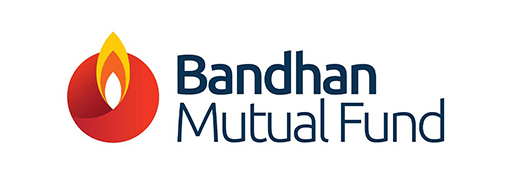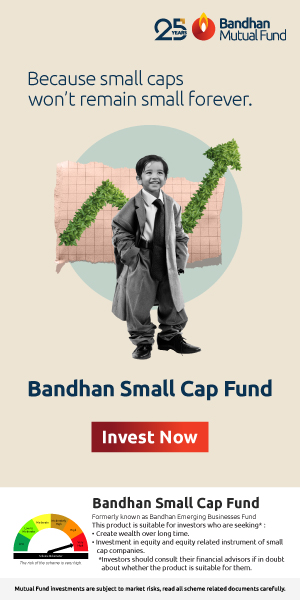Bandhan Multi Factor Fund: Fine tuning strategies with market conditions to create

Bandhan MF has launched a new fund offer (NFO) Bandhan Multi-Factor Fund. Bandhan Multi-Factor Fund is an open-ended thematic scheme that adopts a data-driven investment approach, leveraging a range of widely recognized quantitative factors. The goal is to construct a well-diversified portfolio, based on multiple factors, primarily consisting of large and mid-cap companies, aiming to maximize returns while effectively managing risk.
The fund utilizes a proprietary quantitative model which focuses on core factors such as Momentum, Low Volatility, Value, and Quality chosen for its strong empirical support. The quantitative model's premise is on combining fundamental factors and behavioural factors to achieve a more consistent return across market and economic cycles. By blending multiple factors that perform differently in different market environments, this strategy will endeavour to mitigate concentration risk and enhances overall portfolio stability. The NFO opened for subscription on 10th July 2025 and will close on 24th July 2025.
What are factors?
Factors are characteristics or qualities of stocks which have historically driven portfolio risk and return. Common factors are as follows:-
- Momentum: Momentum refers trend in share price movement, upwards of downwards. In this strategy the fund manager will invest in stocks that are trending upwards and will avoid stocks that are trending downwards.
- Value: Value stocks refer to companies which may be trading at significant discounts to their intrinsic or fair valuation. Value stocks provide a margin of safety and have the potential of giving superior returns when valuation rerating (market discovers the intrinsic value) takes place.
- Volatility: Volatility refers to the deviation in returns from the average. In this strategy the fund manager will select stocks with stable prices and lower volatility. Low volatility stocks can outperform the market when the market is falling
- Quality: Fundamentally strong companies with low debt ratio. In this strategy fund managers select stocks with high earnings per share growth, high return on equity and low debt equity ratios.
Different factors perform better in different market phases
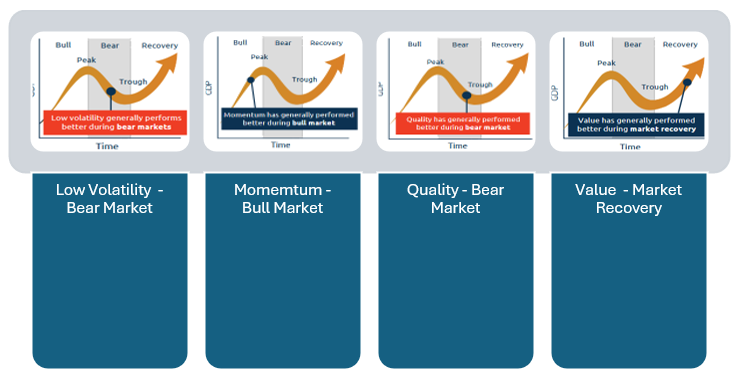
The table below shows how performance of different factors varied across market cycles.
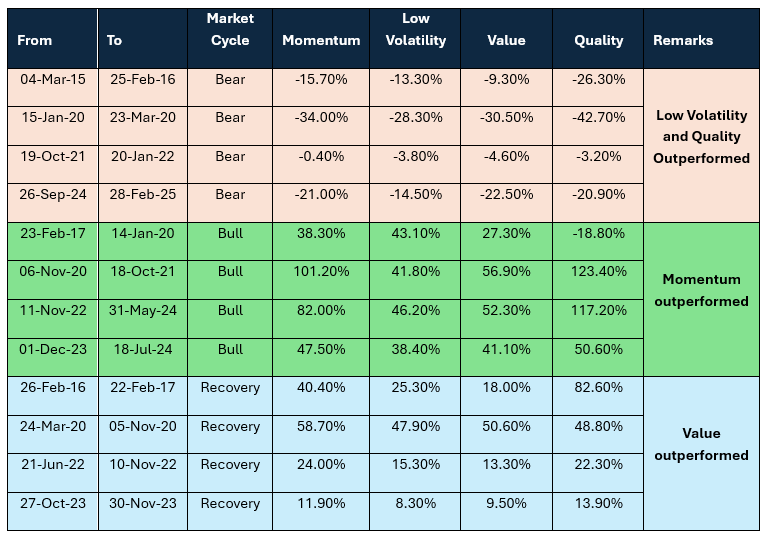
Source: NSE, Bandhan MF. Momentum factor is represented by Nifty 500 Momentum 50, Low volatility by Nifty 500 Low Volatility 50, Value by Nifty 500 Value 50 and Quality by Nifty 500 Quality 50
The chart below shows the calendar year returns of different factor indices over the last 10 years. You can see that factor returns are consistent across years. However, you can also see that in each one or more factors outperformed the broad market index. A strategy combining these factors and re-calibrating weights for each factor depending on market conditions / outlook can provide stability and create alphas across market cycles.
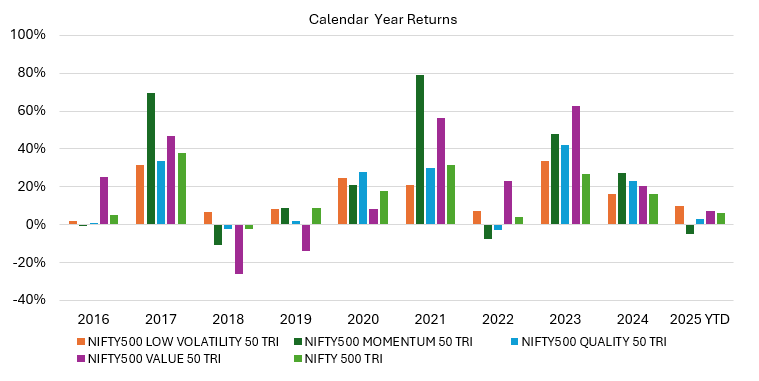
Source: NSE, Advisorkhoj, as on 30th June 2025
About Bandhan Multi-Factor Fund - What are the factors?
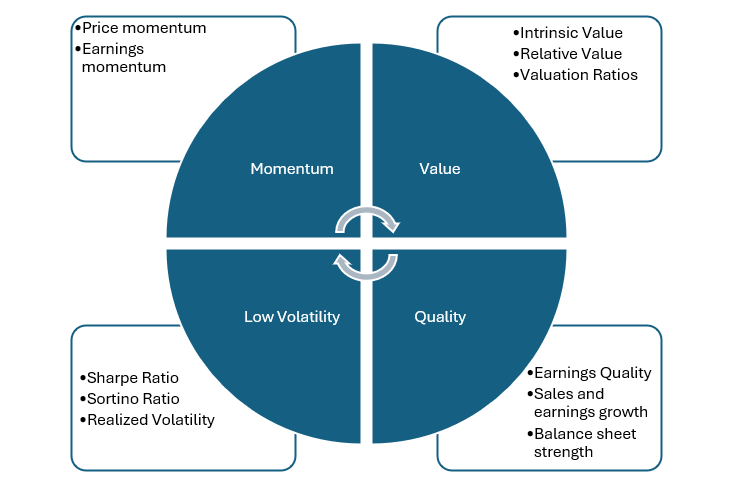
Bandhan Multi-Factor Fund - Portfolio construction
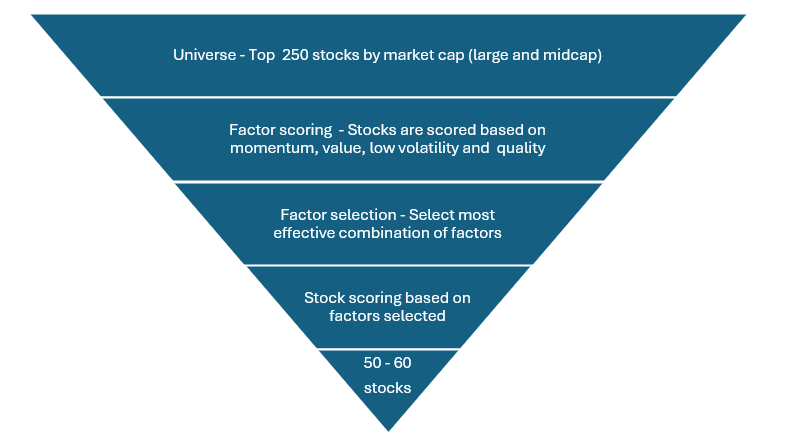
The portfolio construction process follows a top-down approach, beginning with universe selection, followed by factor selection, and culminating in stock selection. The methodology is structured as follows:
Universe Selection
- Primary focus on the Top 250 companies covering the Large and Midcap space.
Factor Selection
- A set of parameters are evaluated across four core factor categories which are as follows:

- Calculate scores to each stock across all parameters. Data is winsorized and normalized prior to score computation.
- Calculate the score of each factor by measuring the average scores of the top 20% of stocks for each parameter.
- Select the top parameters on the basis of their highest score.
Stock Selection
- Compute a composite score for each stock across the top selected parameters.
- Select approximately 50-65 stocks with the highest composite scores for inclusion in the model portfolio.
- Assign portfolio weights to each stock proportionate to their composite score, ensuring that stronger factor score receives a higher allocation.
The portfolio will be rebalanced on a monthly basis to reflect updated factor scores and market data. While the portfolio is primarily constructed using a systematic, rules-based approach, the fund manager retains discretion to make adjustments if required.
Multifactor model outperformed individual factors over long investment tenure
The chart below shows the returns of multifactor model versus individual factors (e.g., momentum, value, low volatility, quality) and Nifty large and midcap index from 1st January 2015 to 31st May 2025. You can see that model outperformed the individual factors and the broad market index.
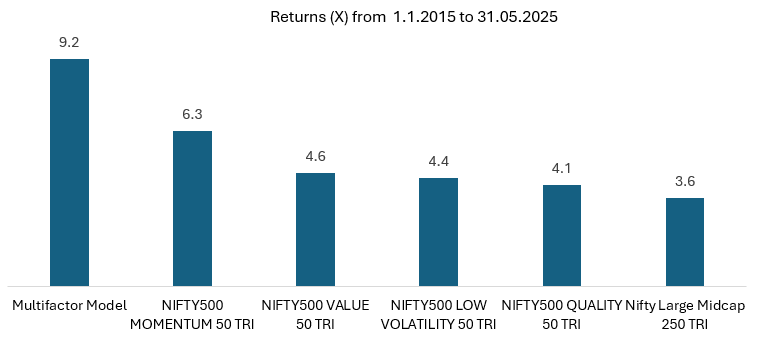
Source: NSE, Bandhan MF, Advisorkhoj, Period: 1st January 2015 to 31st May 2025
Multifactor model had more instances of higher returns across market conditions
The chart below shows the 3 year rolling returns distribution of the Multifactor model over different return ranges from 1st January 2015 to 31st May 2025 covering different market conditions and investment cycles. You can see that the multifactor model gave 18%+ CAGR returns in 79% of the instances (observations) which is significantly higher than the individual factors.
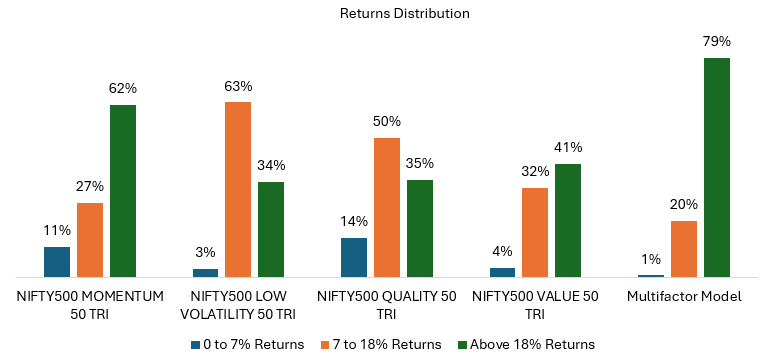
Source: NSE, Bandhan MF, Advisorkhoj, Period: 1st January 2015 to 31st May 2025
Multifactor model - Superior risk / return trade-off versus broad market indices and peers
The chart below shows the average 1, 3 and 5 year rolling returns of the multifactor model versus Nifty 100 TRI and Nifty Large Midcap 250 TRI. You can see that the average rolling returns of the model across different investment tenures was significantly higher than broad market indices.
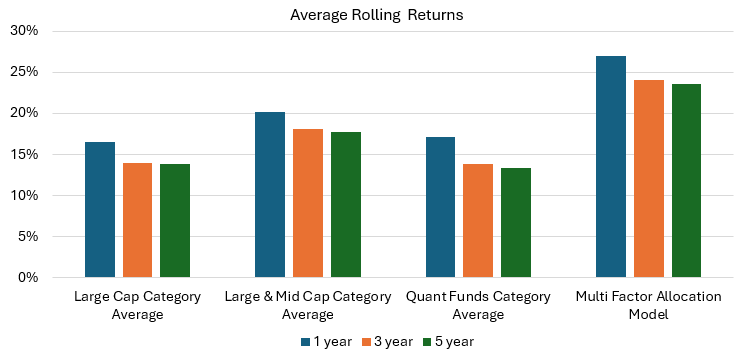
Source: NSE, Bandhan MF, Advisorkhoj, Period: 1st January 2015 to 31st May 2025
At the same time, the volatility of the multifactor model was nearly the same or only slightly higher than that of the broad market indices (see the chart below). In other words, the multifactor model offered superior risk return trade-off.
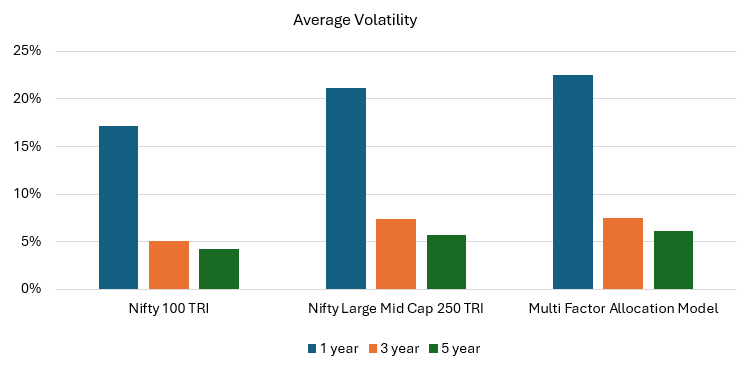
Source: NSE, Bandhan MF, Advisorkhoj, Period: 1st January 2015 to 31st May 2025
The chart below shows the average 1, 3 and 5 year rolling returns of the multifactor model versus large cap, large and midcap and quant funds category average. You can see that the average rolling returns of the model across different investment tenures was significantly higher than category averages.
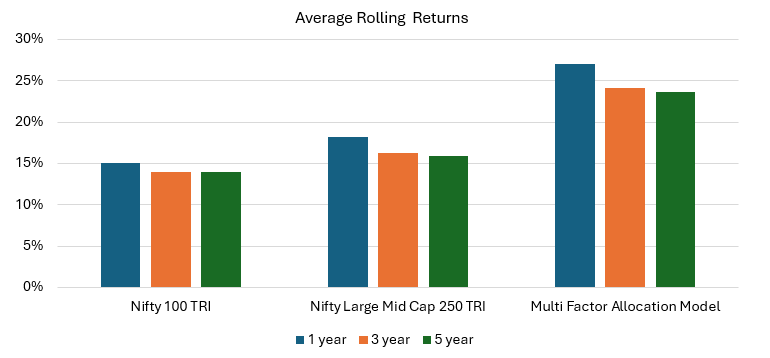
Source: NSE, Bandhan MF, Advisorkhoj, Period: 1st January 2015 to 31st May 2025
At the same time, the volatility of the multifactor model was nearly the same or only slightly higher than that of the peer category averages.
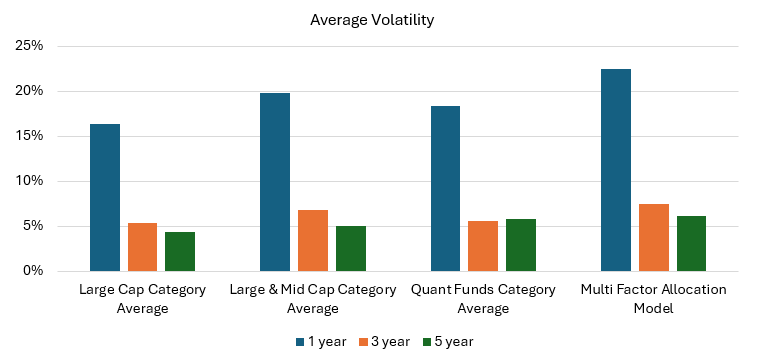
Source: NSE, Bandhan MF, Advisorkhoj, Period: 1st January 2015 to 31st May 2025
Multifactor Model - High active share
The model portfolio will have active share compared the benchmark index, BSE 200 (see the chart below). A high active share indicates that the model portfolio deviates meaningfully from the benchmark, potentially offering more alphas to investors.

Source: Bandhan MF, Period: 1st January 2015 to 31st May 2025
Multifactor Allocation Model: Factor allocation will be re-calibrated in different market phases
Historically, the model had allocated more to momentum and value stocks during bull markets and recovery phases, while favouring low volatility and quality stocks during bear markets.
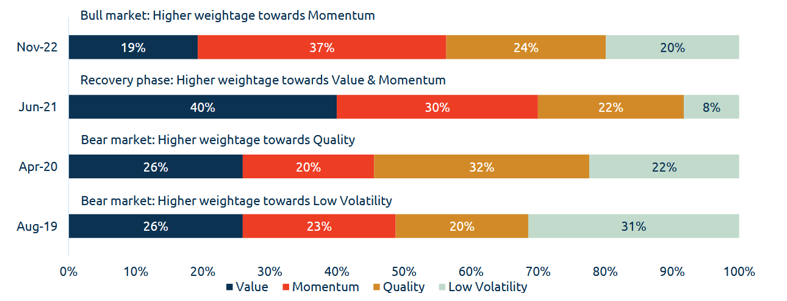
Source: Bandhan MF, Period: 1st January 2015 to 31st May 2025
Multi-factor model - Diversified sector exposure
Bandhan MF's multifactor allocation model provided exposure to diverse sectors and avoided concentrations risks.
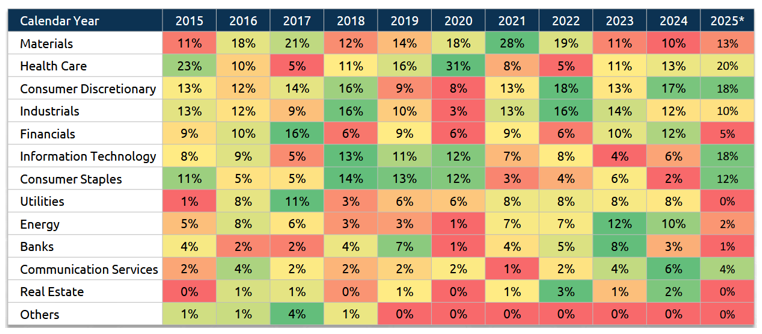
Source: Bandhan MF, Period: 1st January 2015 to 31st May 2025*
Who should invest in Bandhan Multi-Factor Fund?
- Investors seeking capital appreciation over long investment tenure
- Investors who want to invest primarily in large and midcap stocks
- Investors who prefer disciplined, data driven investment strategy
- Investors with high-risk appetites
- Investors with minimum 5 year investment tenure
Investors should consult with their financial advisors or mutual fund distributors if Bandhan Multi-Factor Fund is suitable for their investment needs.
Mutual Fund Investments are subject to market risk, read all scheme related documents carefully.
Bandhan AMC Limited (formerly IDFC Asset Management Company Limited), established in 2000, is one of India's Top 10 fund houses in terms of Asset Under Management. It has an experienced investment team with an on-the-ground presence in over 60 cities. Bandhan Mutual Fund is focused on helping savers become investors and create wealth. To support this objective, the fund house's equity and fixed-income offerings aim to provide performance consistent with their well-defined objectives. It is having its Registered Office at - Bandhan AMC Limited, One World Center, 6th floor, Jupiter Mills Compound,841, Senapati Bapat Marg, Elphinstone Road, Mumbai: 400 013
Investor Centre
Follow Bandan MF
More About Bandan MF
POST A QUERY



